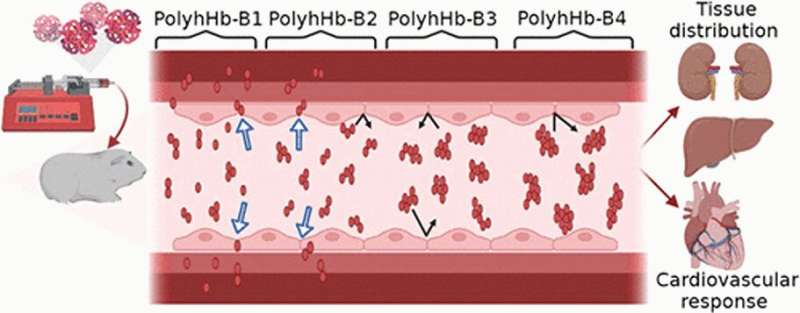This article has been reviewed according to Science X's editorial process and policies. Editors have highlighted the following attributes while ensuring the content's credibility:
fact-checked
peer-reviewed publication
trusted source
proofread
Leaps in artificial blood research aim to improve product safety, efficacy

Researchers have made huge strides in ensuring that red blood cell substitutes—or artificial blood—are able to work safely and effectively when transfused into the bloodstream.
The key is to make the artificial blood molecules big enough so they don't leak from blood vessels into tissue and cause dangerous cardiovascular side effects, notes a new study led by researchers from The Ohio State University.
Although blood loss is typically treated by transfusing units of donated blood, in cases where transfusions aren't readily available or time is too limited to screen for patient blood type compatibility (such as in certain rural areas or on the battlefield), artificial blood products offer medical professionals more flexibility for treatment. In clinical trials, previous generations of these blood substitutes often resulted in several poor health outcomes, as individuals experienced symptoms ranging from narrowing of blood vessels and high blood pressure to tissue injury.
In this study, researchers found that a certain sized fraction of red blood cell substitute can provide a range of health benefits, and can decrease the risk of cardiovascular side effects—if its components are the right size.
"We found that as you make the red blood cell substitute molecules bigger, you have fewer side effects," said Alisyn Greenfield, lead author of the study and a Ph.D. student in chemical and biomolecular engineering at Ohio State. "There's even a particular size range that has better benefits when it comes to the kind of cardiovascular effects that were seen with with previous generations of this material."
Their findings were published in the journal Biomacromolecules.
The researchers tested a red blood cell substitute called polymerized human hemoglobin—PolyhHb. Although past commercial versions have been explored in clinical settings, they did not receive FDA approval due to their many side effects.
To find a better solution, the team focused on identifying a target therapeutic size of PolyhHb by synthesizing material in four different-sized brackets and exploring the cardiovascular response in guinea pig models. Findings showed that the largest-sized brackets did not escape the blood vessels, or cause the blood vessels to narrow and elicit high blood pressure.
Study senior author Andre Palmer, professor of chemical and biochemical engineering at Ohio State, said the antioxidant status of guinea pigs is more similar to humans than other rodents, making them a good model for the study.
While these red blood cell substitutes aren't meant to replace blood entirely, this research highlights the potential of these materials. If transfused into a person soon after injury, they could be used to buy the person enough time to be transported to a medical facility to receive a blood transfusion, said Palmer.
Additionally, because blood substitutes aren't made with any surface antigens or markers on the outside of the red blood cell's membrane, they can be transfused into anyone, regardless of their blood type. That said, artificial blood is still a long way from commercialization.
Even though it can be stored at room temperature for several years compared to the 42-day storage period for donated blood, artificial blood doesn't come close to replicating the lifetime of real blood cells, said Palmer. Once produced, a typical red blood cell circulates in the human body for a period of about 120 days, yet the materials in current blood substitutes are made with only a half-life of about 24 hours after administration.
Further study is needed to more accurately determine the red blood cell substitute's safety and efficacy in clinical settings. "By performing this study, we demonstrated that we can improve upon what currently exists and, hopefully, be able to move our research forward and translate those materials into the clinic," said Greenfield.
More information: Alisyn Greenfield et al, Biophysical Analysis and Preclinical Pharmacokinetics–Pharmacodynamics of Tangential Flow Filtration Fractionated Polymerized Human Hemoglobin as a Red Blood Cell Substitute, Biomacromolecules (2023). DOI: 10.1021/acs.biomac.3c00051
Journal information: Biomacromolecules
Provided by The Ohio State University





















